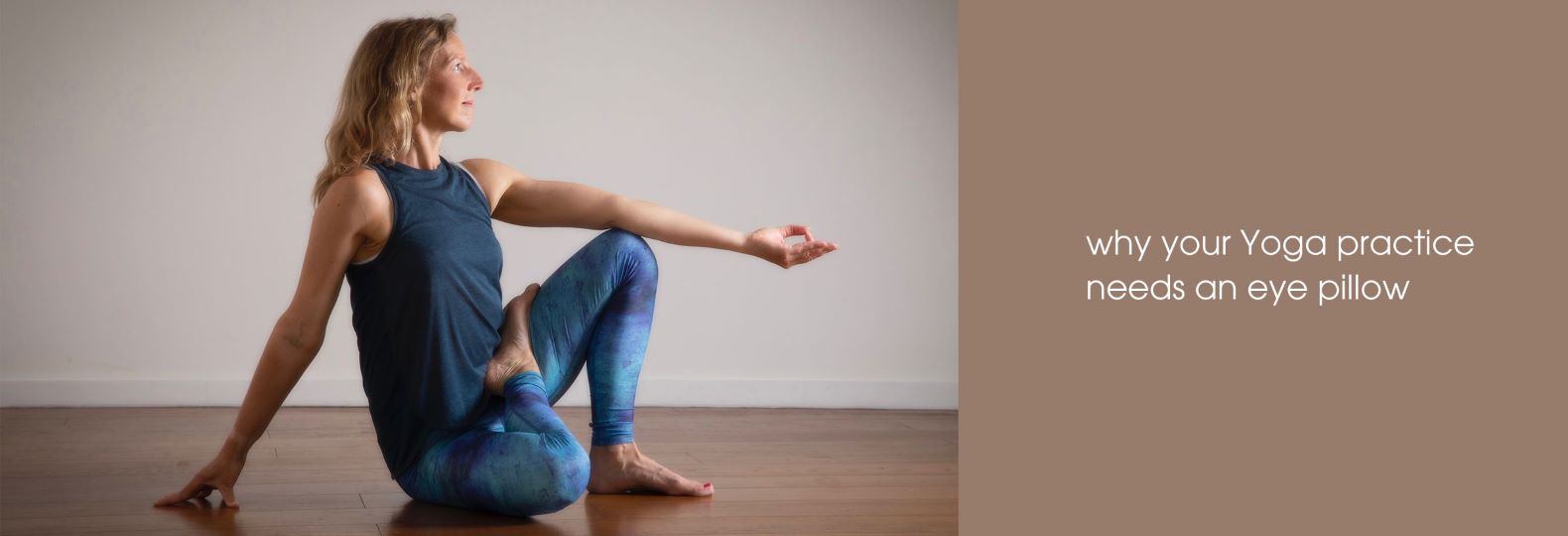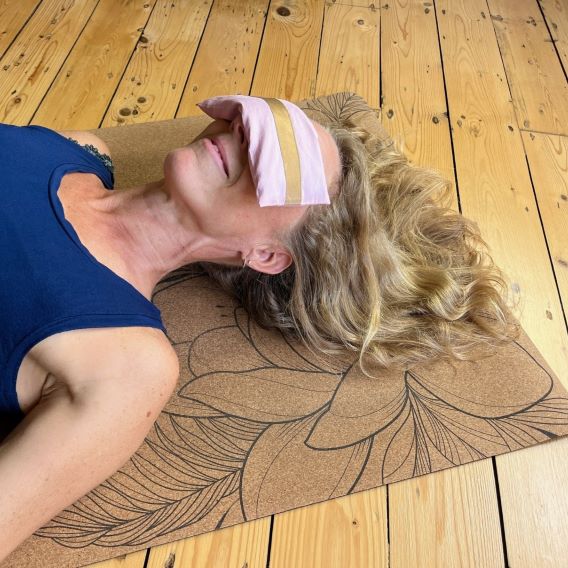Benefits of Eye Pillows in Yoga
You may be attending a yoga class or a workshop or retreat and just before relaxation or yoga nidra be asked by the yoga teacher “would you like an eye pillow?”. Perhaps already a fan of eye masks and eye pillows, you immediately respond “yes please” but if you haven’t ever tried them and are wondering how you might answer that question maybe the following will be of help!
An eye pillow can enrich relaxation and rest and induce a deep sense of calm and whether teaching yoga or working with clients in yoga therapy I encourage their use unless otherwise indicated.
We can often tell from a person’s eyes if they are tired or stressed. We live in overstimulated times, spend hours looking at our phones and on laptops and simply allowing the muscles in our eyes to rest whether via a mask or eye pillow can be incredibly soothing. However, although having many of the same benefits there are some important differences between eye masks, eye pillows and weighted eye pillows which I explain below.
Eye Masks
Popular on flights or when going to sleep, these have the benefit of blocking out light and the visual stimuli that creates. They are certainly a useful aid to sleeping better. They also send a clear message to others around us that wearing the eye mask means we would like to be left alone and have some rest (always a bonus on a busy flight!). Silk eye masks are incredibly soothing and gentle to the skin and minimise skin creasing.
Yet, unlike eye pillows they generally don’t apply the gentle pressure which sends additional signals to the body to rest via stimulation of the vagus nerve and more. Why is this important? Read on below.
Eye Pillows and Weighted Eye Pillows
Also, a useful aid to blocking out light, eye pillows weighted and otherwise have a myriad of benefits.
Weighted eye pillows apply gentle pressure, a little like a gentle hug for the eyes and the application of pressure is important.
I have written previously about the vagus nerve and its link to our immune and digestive systems and how stimulating the vagus nerve helps regulate both sympathetic hyper arousal (fight/flight) and parasympathetic hypo-arousal (lethargy/freeze).
The vagus nerve passes through the abdomen, diaphragm and to the throat, ear and facial muscles meaning that the vagus nerve and eyes are connected. Indeed, the nerve endings of the twelve extraocular muscles of the eyes which extend down to the suboccipital muscles of the upper cervical vertebral in the neck (another area which holds tension) have a direct connection to the vagus nerve.
Eye movements can stimulate the vagus nerve and relaxing the muscles in and around the eyes via the engagement of the innate reflex called the occulocardiac reflex (OCR) activates a parasympathetic response slowing down heart rate and lowering blood pressure and invoking that sense of calm.
Gentle pressure on the eyes via a weighted eye pillow can have a calming effect upon the nervous system by the stimulation of the OCR. Alternatively placing the palms over the eyes, as I explain in the exercise below, with the addition of gentle pressure may have a similar effect.
In addition to having a calming effect upon the nervous system and soothing stress and anxiety
Other benefits might include
. Relieving eye strain, headaches and migraines – Tension in the muscles around the eyes which exacerbates the discomfort arising from headaches and similar can be soothed by the weight and warmth of eye pillows. Eye strain from looking at computers and our phones for long periods can cause dry itchy sore eyes and similarly might be eased by the gentle weight of an eye pillow.
. Mindfulness tool – The weight of an eye pillow adds to the sense of “grounding” and presence during a mindfulness practice. They are wonderful to use during Yoga Nidra and practices inviting relaxation whilst maintaining awareness.
. Improving sleep – As with an eye mask, eye pillows are a great way to signal to our brain that it’s time to rest!
. Stimulating the senses – Many eye pillows are infused with lavender which is known for its calming properties, and we know that smell is connected to our memory so an eye pillow with a smell associated with your happy pace could be instantly soothing.
. Alleviating sinus problems or eye conditions – A warm eye pillow might help sooth inflamed and congested sinuses or conditions such as blepharitis and a chilled eye pillow can be a refreshing aid to sore itchy eyes (hayfever!).
Eye pillows are compact and portable and provide a small yet impactful step in prioritising our health (physical, physiological and emotional) and can be a useful enhancement to relaxation. If you don’t fancy using those on offer in classes or on retreats, then taking your own eye pillow with you is a very viable option. There are some beautiful eye pillows available to purchase and its rather nice having your own!
One of my favourite eye exercises for tired eyes
What to do if you don’t have an eye pillow or equivalent to hand? The below is an exercise I might use at the end of class especially if I know students have just finished work. It is also nice for dry, irritated sore and tired eyes. It’s quick, easy and a simple practice to do if feeling a little overstimulated and wired.
. Sit comfortably.
. Rub your palms together generating heat.
. With your eyes closed gently place your hands over your eyes – bathing your eyes with the heat generated and trying to block out as much light as possible. You can apply gentle pressure on the eyes or continue to “cup” the eyes.
. Take some longer inhalations and exhalations.
. Slowly open your eyes but keep your gaze soft (looking down) and keep your hands where they are for a little longer enjoying the softer light until you wish to lower them and adjust to the stronger light.
Written for Holistic Silk by Lorna Fisher
580hr Yoga Therapist BCYT/NCIP 200hr Certified Yoga Teacher
https://www.lornafisheryoga.co.uk/






